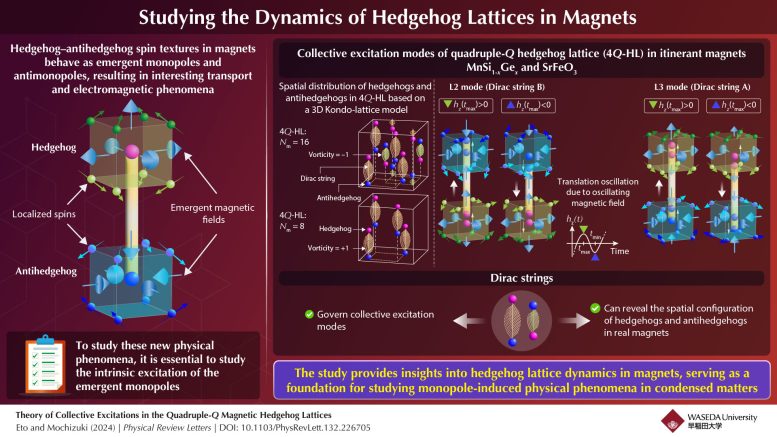Recent discoveries in materials such as manganese germanide have unveiled structures that behave like magnetic monopoles. Researchers have identified new dynamic properties in these structures, potentially paving the way for innovative technologies in spintronics and fundamental physics research. Credit: SciTechDaily.com
Researchers have unveiled the dynamical nature of emergent magnetic monopoles in real magnets for the first time.
Magnetic monopoles are elementary particles with isolated magnetic charges in three dimensions. In other words, they behave as isolated north or south poles of a magnet. Magnetic monopoles have attracted continuous research interest since physicist Paul Dirac’s first proposal in 1931.
However, real magnetic monopoles have not yet been observed and their existence remains an open question. On the other hand, scientists have discovered quasi-particles that mathematically behave as magnetic monopoles in condensed matter systems, resulting in interesting phenomena.
Recently, researchers discovered that a material called manganese germanide (MnGe) has a unique periodic structure, formed by special magnetic configurations called hedgehogs and antihedgehogs, which is called a magnetic hedgehog lattice. In these special configurations, the magnetic moments point radially outward (hedgehog) or inward (antihedgehog), resembling the spines of a hedgehog. These hedgehogs and antihedgehogs act like magnetic monopoles and antimonopoles, serving as sources or sinks of emergent magnetic fields.

The collective excitation modes of hedgehog lattices are governed by oscillation of Dirac strings, connecting a hedgehog and an antihedgehog, which can be used to study their spatial configuration in magnets. Credit: Masahito Mochizuki from Waseda University
MnGe exhibits what is known as a triple-Q hedgehog lattice. However, recent experiments have shown that the substitution of Ge with Si (MnSi1-xGex) transforms the arrangement into the quadruple-Q hedgehog lattice (4Q-HL). This new arrangement, also found in the perovskite ferrite SrFeO3, provides a promising avenue for studying and controlling the properties of hedgehog lattices. Moreover, these magnetic monopoles can also induce electric fields through moving following Maxwell’s laws of electromagnetism. To understand the resulting new physical phenomena, it is essential to study the inherent excitations of hedgehog lattices.
Research Findings from Waseda University
In a recent study, Professor Masahito Mochizuki and Ph.D. course student Rintaro Eto, both from the Department of Applied Physics at Waseda University, theoretically studied the collective excitation modes of 4Q-HLs in MnSi1-xGex and SrFeO3. “Our research clarified the unknown dynamical nature of emergent magnetic monopoles in magnetic materials for the first time. This can inspire future experiments on hedgehog-hosting materials with applications in electronic devices and for bridging particle physics and condensed-matter physics,” says Mochizuki. Their study was published in the journal DOI: 10.1103/PhysRevLett.132.226705











/https://tf-cmsv2-smithsonianmag-media.s3.amazonaws.com/filer_public/34/31/3431771d-41e2-4f97-aed2-c5f1df5295da/gettyimages-1441066266_web.jpg)







Discussion about this post